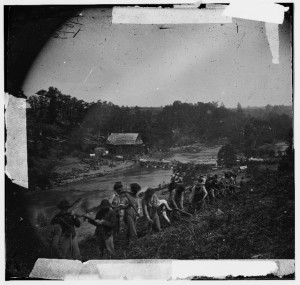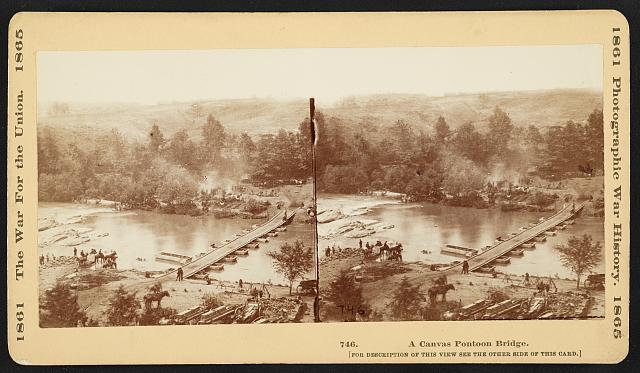Captain James H. McDonald of the 50th New York Engineers has already served in the war for over three years. He recovered from being wounded in the arm at Fredericksburg. In this recruiting letter he promoted the Engineers as being the most desirable branch in the service during a siege, at least for the enlisted men. He also believed that if the North had enough will for war and enough men in its armies, it was only a matter of time before the South would succumb.

on the regiment’s resume: “Jericho Mills, Virginia. Party of the 50th New York Engineers building a road on the south bank of the North Anna River” May 24, 1864
From a Seneca County, New York newspaper in 1864:
LETTER FROM CAPT. MCDONALD.
HEADQUARTERS 3d BATTALION,
50th N.Y. ENGINEERS, NEAR PETERS-
BURG, Va., August 25th, 1864.
HON. BENSON OWEN – Dear Sir: – I observed in the Courier that you were connected with the recruiting business. As my regiment is one of the most desirable organizations in the service to enlist into, on account of pay, comfort, and chances for promotion to intelligent mechanics, I have taken the liberty of writing you on the subject. There is at present a vacancy for one hundred and fifty men. My Company numbers one hundred and forty-five men, and I can give a place to five good mechanics.
I lost one man killed at the Chickahominy, June 12th, and have had very few men hurt at all; so you see the chances for returning after the war are better than in an infantry regiment. The officers have far more cause to fear being mustered out by the Johnnies’ bullets than the men, because the former have charge of large details of infantry during a siege, while the enlisted men are preparing siege material at a safe distance in the rear.
If there is any branch in the service that has the preference over all others, it is the Engineers, especially to an enlisted man, if he is intelligent, active and persevering. I presume more recruits can be had for the regiment than any other, as I have frequent applications to transfer sergeants of infantry to my Company as privates. Anything you can do for my Company in this way I assure you will be appreciated very highly.
As a friend to the policy of prosecuting the war in the most vigorous manner, you can appreciate our feelings, and justify the sentiments when we say, “Give us more men, and that speedily, and the Rebellion is used up.” If we had one hundred thousand fresh troops given us to-day, the war would end in three months. There is no possible doubt about this; for by simply holding the Rebel forces where they are, and cutting off there communications, they are annihilated by their own stomachs. Give us more men here; roll up a vote this Fall that will strengthen the arm and warm the heart of the soldier, and we will soon come out of this contest victorious.
Yours very respectfully,
JAS. H. MCDONALD,
Captain, 50th N.Y. Engineers.
As stonesentinels points out one enlisted man in the 50th had a bit different view of a siege and its relative safety. A marker at Petersburg quotes Thomas M. Blythe of the 50th:
Monotonous Toil
“The romance of a soldier’s life disappears in a siege. The change of scenery and the lively marches are gone, and the same monotonous unvaried rounds of toil take their place. Sunday and weekday are all alike.”
T.M. Blythe
50th N.Y. Engineers
In his new book, Walt Gable, our County Historian, wrote about an incident involving Captain McDonald and his company from a couple years before this letter:
On August 13, 1862, McDonald’s Company K was ordered to the Chickahominy River, some twenty miles distant, to prepare the way for the army [of the Potomac] to evacuate the peninsula. Arriving at Charles City Court-House, they found a gallows standing in the courthouse yard. An aged Negro told them that it had been used to hang several of his race who had attempted to escape slavery. Company K men used their axes to destroy the gallows and used the wood as a campfire to heat their coffee.[1]
“Stereograph showing an aerial view from the north bank of the North Anna River of a canvas pontoon bridge constructed by the 50th New York Engineers near Jericho Mills, Virginia in May 1864.”
- [1]Gable, Walter Seneca County And The Civil War. Charleston, S.C.: The History Press, 2014. Print. page 56.↩


